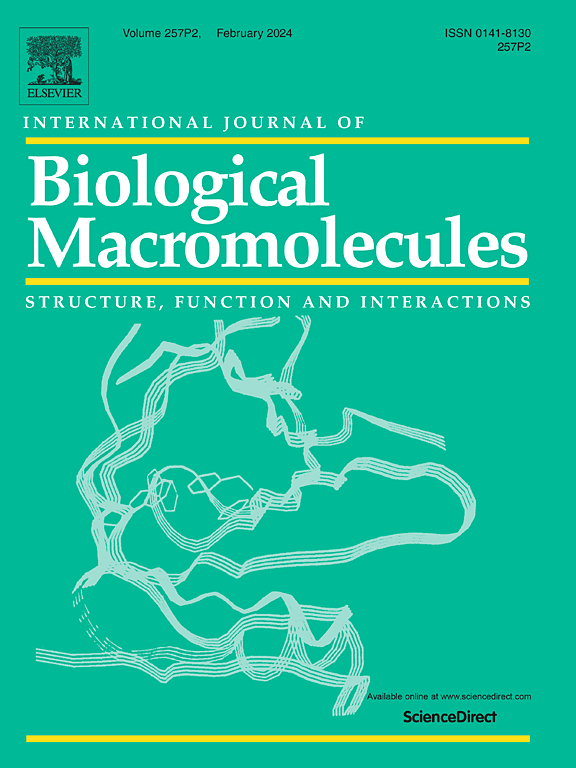海藻酸盐-棘豆粉偶联物微胶囊化鼠李糖乳杆菌GG
IF 8.5
1区 化学
Q1 BIOCHEMISTRY & MOLECULAR BIOLOGY
International Journal of Biological Macromolecules
Pub Date : 2025-05-29
DOI:10.1016/j.ijbiomac.2025.144793
引用次数: 0
摘要
由于其已被证明具有促进健康的作用,因此在植物性生物活性化合物中出现了Pereskia aculeata (ora-pro-nobis - OPN)。本研究以OPN面粉和海藻酸钠(ALG)为复合基质,采用外离子凝胶法对鼠李糖乳杆菌GG进行包封,并在不同条件下分别和共同对其进行活性、稳定性和相互作用评价。在2°C、22°C和35°C条件下储存60天,并进行胃肠模拟。OPN粉代代时间为6 h 79 min,有利于细菌增殖。直径为2 ~ 4 mm和1 ~ 5 mm的ALG微胶囊和ALG/OPN微胶囊的包封率均超过94%。扫描电镜显示ALG/OPN微胶囊呈现球形或椭圆形结构,表面均匀,而ALG/OPN微胶囊呈现轻微变形。ALG/OPN微胶囊在22°C和35°C条件下分别保存60天和15天,其抗氧化活性(DPPH抑制率为21.39%)和益生菌活力均有所提高。在胃肠模拟实验中,ALG/OPN胶囊保存了6.9 log CFU/g,而游离和纯ALG胶囊保存了1.0 log CFU/g。本研究首次证实了刺草粉作为益生菌包封材料的有效性。本文章由计算机程序翻译,如有差异,请以英文原文为准。
Alginate-Pereskia aculeata flour conjugates for the microencapsulation of Lacticaseibacillus rhamnosus GG
Pereskia aculeata (ora-pro-nobis – OPN) has emerged among plant-based bioactive compounds due to its proven health-promoting effects. This study aimed to encapsulate Lacticaseibacillus rhamnosus GG using external ionic gelation with a composite matrix of OPN flour and sodium alginate (ALG), evaluating viability, stability, and interaction separately and together under different conditions. Encapsulated probiotics were assessed after 60 days of storage at 2 °C, 22 °C and 35 °C, and gastrointestinal simulation. OPN flour facilitated bacterial proliferation with a generation time of 6 h 79 min. Encapsulation efficiency exceeded 94 % for ALG and ALG/OPN microcapsules, with diameters ranging from 2 to 4 mm and 1–5 mm, respectively. Scanning electron microscopy revealed that ALG/OPN microcapsules exhibited spherical or elliptical structures with homogeneous surfaces, while ALG-only capsules displayed slight deformations. ALG/OPN microcapsules showed increased antioxidant activity (21.39 % DPPH inhibition) and excellent probiotic viability during 60 days of storage at 22 °C and 15 days at 35 °C. Under gastrointestinal simulation, ALG/OPN preserved 6.9 log CFU/g, compared to 1.0 log CFU/g for free and ALG-only capsules. This study provides the first evidence supporting using P. aculeata flour as an effective material for probiotic encapsulation.
求助全文
通过发布文献求助,成功后即可免费获取论文全文。
去求助
来源期刊
CiteScore
13.70
自引率
9.80%
发文量
2728
审稿时长
64 days
期刊介绍:
The International Journal of Biological Macromolecules is a well-established international journal dedicated to research on the chemical and biological aspects of natural macromolecules. Focusing on proteins, macromolecular carbohydrates, glycoproteins, proteoglycans, lignins, biological poly-acids, and nucleic acids, the journal presents the latest findings in molecular structure, properties, biological activities, interactions, modifications, and functional properties. Papers must offer new and novel insights, encompassing related model systems, structural conformational studies, theoretical developments, and analytical techniques. Each paper is required to primarily focus on at least one named biological macromolecule, reflected in the title, abstract, and text.

 求助内容:
求助内容: 应助结果提醒方式:
应助结果提醒方式:


